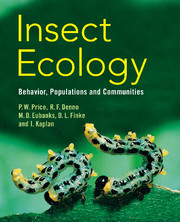Book contents
- Frontmatter
- Contents
- Preface
- Acknowledgments
- Part I Introduction
- Part II Behavioral ecology
- Part III Species interactions
- Part IV Population ecology
- 9 Demography, population growth and life tables
- 10 Life histories
- 11 Population dynamics
- Part V Food webs and communities
- Part VI Broad patterns in nature
- Glossary
- References
- Author Index
- Taxonomic Index
- Subject Index
- Plate section
- References
11 - Population dynamics
from Part IV - Population ecology
Published online by Cambridge University Press: 05 June 2012
- Frontmatter
- Contents
- Preface
- Acknowledgments
- Part I Introduction
- Part II Behavioral ecology
- Part III Species interactions
- Part IV Population ecology
- 9 Demography, population growth and life tables
- 10 Life histories
- 11 Population dynamics
- Part V Food webs and communities
- Part VI Broad patterns in nature
- Glossary
- References
- Author Index
- Taxonomic Index
- Subject Index
- Plate section
- References
Summary
All natural populations fluctuate: they are dynamic. introduced the concepts of population growth and regulation. How and why populations change are the subjects of this chapter. Population dynamics has been of major concern in insect ecology for at least two reasons. First, ecology has been defined as the study of the distribution and abundance of species (Andrewartha and Birch 1954, Krebs 1972). Since the study of population dynamics must include both changes in numbers over time and over the landscape, the subject acts as a central theme in ecology: a unifying concept that permeates the science. It is therefore critical to the conceptual development of ecology. Second, the subject is directly applicable to problems in managing plants as resources for humans, in agriculture, horticulture and forestry. In fact, the need to monitor and understand insect damage to crops and forests was a major motivation for the beginnings of ecology and the study of population dynamics. Other applications include the study of vectors of diseases, such as mosquitoes, pests of cattle such as ticks and screwworm, and vectors of plant pathogens. For these reasons the field of insect population dynamics has played a prominent role in the development of basic ecology and in the understanding and management of serious pests over the landscape.
First we will examine major patterns in populations and then move on to mechanisms that may be driving these patterns, including abiotic and biotic influences, and complex interactions involving both. We also consider the question of how common eruptive species are, how frequently eruptions occur, and whether outbreaks result from human interference with natural dynamics. We note that long-term studies are essential in deciphering the reasons for population change, but many potential influences need to be investigated. Bottom-up effects from plants, top-down effects from natural enemies and lateral effects all need attention. Spatial distribution of populations is also important in a fragmented landscape, covered by the field of metapopulation dynamics. Population dynamics is a field of wide application for understanding pest species, epidemiology, biological control and conservation, all requiring information for planning and management.
- Type
- Chapter
- Information
- Insect EcologyBehavior, Populations and Communities, pp. 404 - 440Publisher: Cambridge University PressPrint publication year: 2011



